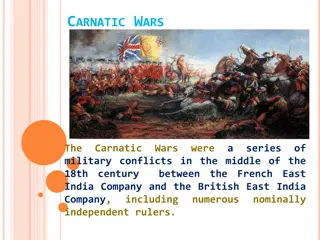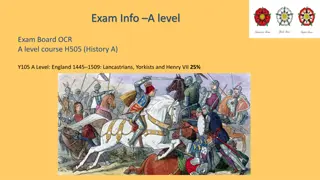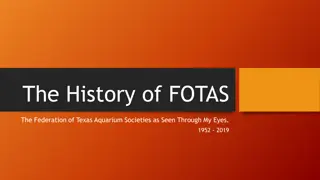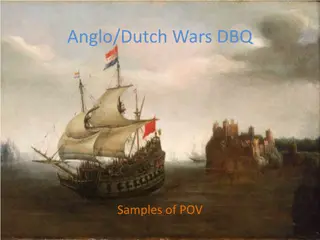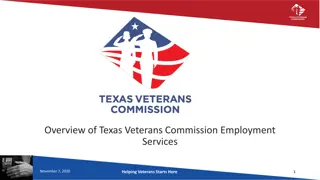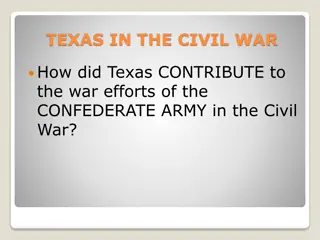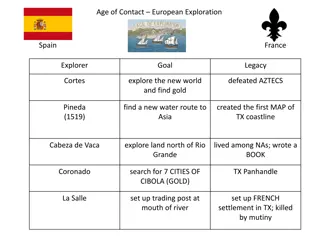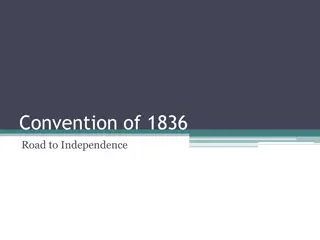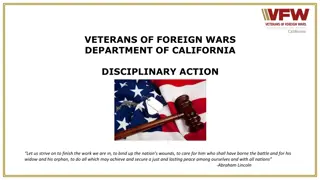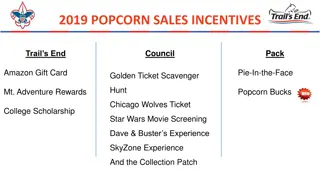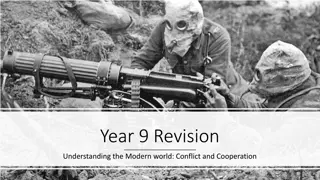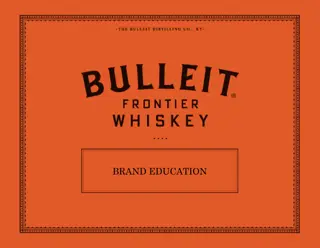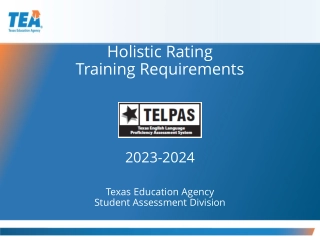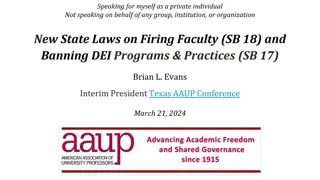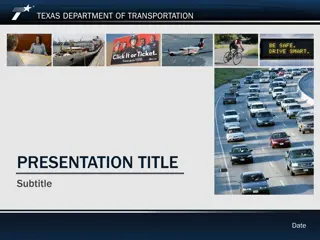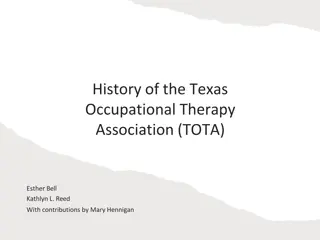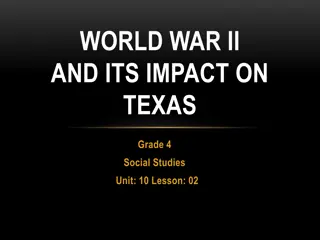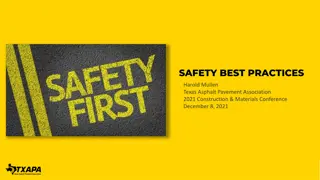Texas Frontier Wars: A Historical Overview
Explore the conflict and interactions between Native Americans and Anglo-Americans in Texas through key events like the Civil War, Emancipation Proclamation, and the influence of important figures like Kiowa Chief Sitting Bear and Comanche Chief Quanah Parker.
Download Presentation

Please find below an Image/Link to download the presentation.
The content on the website is provided AS IS for your information and personal use only. It may not be sold, licensed, or shared on other websites without obtaining consent from the author. Download presentation by click this link. If you encounter any issues during the download, it is possible that the publisher has removed the file from their server.
E N D
Presentation Transcript
Bell Ringer 1. Why was the Civil War fought? 2. What was the Emancipation Proclamation? 3. Who won the Civil War? 4. Explain the 13th, 14th, and 15th Amendments. 5. In your opinion, were the slaves in the South really granted their freedom and rights? Explain your answer
Cultures in Conflict A visual history of the Frontier Wars in Texas A visual history of the Frontier Wars in Texas
Native Native American American Needs Needs LAND Needed for farming and ranching LAND Needed for buffalo vs. vs. Anglo Anglo American American Needs Needs Strengths: Strengths: 1. Knowledge of the territory 1. Forts 2. Federal government support Weaknesses: 2. Skilled fighters Weaknesses: 1. Too few in number 1. Depended on buffalo for survival 2. Forts too far apart 3. Little experience fighting Native Americans 2. Disagreement among leaders
Medicine Medicine Lodge Lodge Treaty Treaty Native Americans -establishes reservations for each tribe in the western part of Oklahoma. -Native Americans must stop making raids on settlements United States -pledges to establish reservation schools and to provide resident farmers who will teach the Indians agriculture - the Army would not be allowed on reservation
Important TX Indian Important TX Indian Chiefs and Warriors Chiefs and Warriors Sitting Bear Kiowa Chief who was killed during transport to Jacksboro for trial after the Warren Wagon Train Raid. Kiowa Kiowa Lone Wolf Kicking Bird White Bear Leader of the War Faction of the Kiowa Tribe. He believed in fighting the whites to keep the Kiowa way of life. Attended the Medicine Lodge Treaty and fought at Adobe Walls. Leader of the Peace Faction of the Kiowa Tribe. He urged his people to adapt and became known for his preaching of peace. Called Orator of the Plains because of his speeches at Medicine Lodge Council. Kiowa Chief involved in the Warren Wagon Train Raid
Quanah Parker Important TX Important TX Indian Chiefs and Indian Chiefs and Warriors Warriors Son of a Comanche chief (Peta Nocona) and an Anglo American woman, Cynthia Ann Parker, who had been captured by the Comanche as a child. Comanche Comanche He became a powerful Comanche chief who fought to stop the spread of the Anglos. Ten Bears Comanche chief known for his speech at the Medicine Lodge Treaty in 1867. "I was born upon the prairie where the wind blew free and there was nothing to break the light of the sun. I was born where there were no enclosures and where everything drew a free breath. I want to die there and not within walls."
President Ulysses S. Grant Replaced military officers on reservations with Quaker agents General William Tecumseh Sherman Important Important White Leaders White Leaders of the Frontier of the Frontier Wars Wars brought the total war tactics he used to crush the Confederacy against the tribes of the Plains Lawrie Tatum General Philip Sheridan Quaker Agent helped deal with the Native Americans in Indian Territory. Commander of the US Military Department of the Southwest. Colonel Ranald S. Mackenzie, 4th Cavalry The leader of the U.S. Army at Palo Duro
Warren Wagon Train Raid The Warren Wagon Train Raid was a raid by the Kiowa that served as a turning point in American Policy toward the Natives of Texas. Site of the Warren Wagon Train Raid Young County, 1871 Sketch depicting Warren Wagon train attack T.J. Owen (the writer O.Henry.) The peace policy adopted after the Medicine Lodge Treaty was abandoned. The Quaker Agents were sent home. The army would stop just defending the settlers they would start attacking.
What the Buffalo Meant to the Native Americans Paunch (stomach) made into water bags Sinews (tendons) and hair were made into bowstrings, rope, and thread Buffalo hide became clothing, saddles, robes, and covers for teepees Hoofs, horns and bones became ornaments, cups, and utensils Buffalo Poo (dung) was used as fuel for fires A Kiowa chief describes it this way: The buffalo is our money the robes we can prepare and trade. We love them just as the white man does his money. Just as it makes a white man feel to have his money carried away, so it makes us feel to see others killing and stealing our buffaloes, which are our cattle given to us by the Great Father above. = Survival
Using Buffalo to Destroy the Native Americans General Philip Sheridan Instrumental in instituting the policy of killing the buffalo to kill the Indians Shooting Buffalo on the Line of the Kansas-Pacific Railroad, c. 1870 Sheridan helped deprive the Indians of their primary source of livelihood. Professional hunters killed over 4 million bison by 1874. When the Texas legislature considered outlawing bison poaching on tribal lands, Sheridan personally testified against it in Austin, Texas. He suggested that the legislature should give each of the hunters a medal, engraved with a dead buffalo on one side and a discouraged-looking Indian on the other.
pushing further west Frontier Line As settlers pushed farther west on the Texas frontier in the 1850s, new army posts were constructed to provide a measure of protection.
Adobe Walls Battle June 1874 One of the battles of the Red River War. Quanah Parker led 100s of warriors from 5 Native American Nations against 29 Anglo buffalo hunters in a failed effort to take over the camp. Quanah Parker 1. The battle was a crushing spiritual defeat for the Native Americans. Led the Comanche at Adobe Walls 2. The Natives increased their attacks on West Texas settlements. Over the next two months they killed over 190 settlers across 5 states. Battle of Palo Duro Canyon September 1874 Anglo Americans won and this was the last effort of the Natives in Texas to stand up against the American military and the advancement of the whites. Red River Red River War War The final stand of the Plains Indians in Texas Colonel Mackenzie, 4th Cavalry Lone Wolf The leader of the U.S. Army at Palo Duro One of the chiefs defeated at the Battle of Palo Duro
Apaches Last Stand In Texas Rattlesnake Springs Battle VICTORIO: Apache leader Col. Benjamin Grierson: White Leader Black Calvary troops from the 9th and 10th Units also assisted in the defeat of the Apaches After this battle the Apaches were defeated and they were out of Texas for good.
Buffalo skulls, mid-1870s, waiting to be ground into fertilizer The End of the Plains Indians The railroad, the development of the hide industry during the 1800s, and the wholesale destruction of the buffalo guaranteed that the Native Americans would no longer have the means to survive Rath & Wright's buffalo hide yard, showing 40,000 buffalo hides baled for shipment. Dodge City, Kansas, 1878
The Results of the The Results of the Frontier Wars of Frontier Wars of Texas Texas 1. Native Americans in Texas moved onto reservations in Indian Territory (Oklahoma) 2. With the Native Americans out of Texas the settlers could move into West Texas and the Panhandle 3. New towns were established in the Western half of the state 4. The cattle industry exploded with the buffalo gone from the Sea of Grass cattlemen now had huge areas in which to raise cattle on their new ranches 5. The forts were no longer needed, so many were closed.
Exit Pass What is your opinion on how the Plains Indians were treated by the Anglo Americans? If you were in charge of making government policies regarding the Native Americans what would you have done differently.





